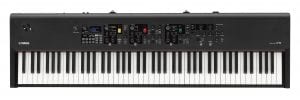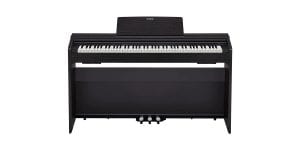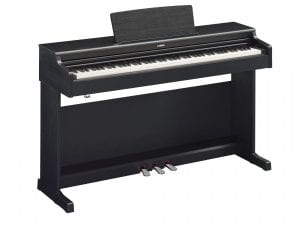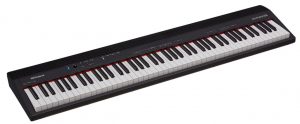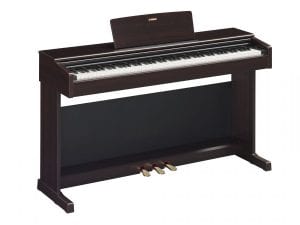If you are looking to buy a piano for your church use and places of worship, you should choose a piano, which is a performance machine, that will never let you down. When choosing to buy a digital piano for church use and use in places of worship, it is important to understand that different churches play different styles of music. Thus, it is important to choose an instrument with different instrument tones and piano playing styles. We have come up with the best digital pianos for church use here, to get your search simpler.
What Are the Best Digital Pianos for Church Use?
Top 5 Best Digital Pianos for Church Use & Worship
If you have been a part of the church choir or have worked with their music band closely, you would have known that certain piano brands are their tried and tested options. We have described them in detail here, to help you make an informed decision on your next best piano for use in religious songs.
#1. Yamaha CP88 – Best Compact Stage Piano For Church Use
Check Price on Online Stores:
When it comes to church choirs and places of worship, Yamaha always offers the best pianos. This is an exceptionally lightweight piano and it weighs only forty-one pounds. Thus, you can easily transport it to the church for playing and for music classes to learn the piano tunes. The Yamaha CP-88 hammer action stage piano comprises 88 natural wooded keys with synthetic ebony and ivory keytops. The piano also features graded hammer GH3 action and it also comprises three premium grand piano sounds and the sounds of electric pianos and grand acoustic pianos.
There are also several effects in this piano that includes Master delay, EQ effects, reverb, and other effects along with dedicated real-time controls. The piano also has seamless sound-switching functionality and it helps in changing sounds while holding the notes without sound cutoff. The piano also includes FC3A sustain pedal.
The Yamaha CP-88 is powered by 100 years of piano craftsmanship from Yamaha and it brags the authentic piano sounds of acoustic and electric pianos. The keyboard action of this piano is powered by 100 years of acoustic piano-making experience. CP-88 is designed to withstand the rigors of strenuous practice and the piano is also extremely intuitive to use.
Pros
- CP-88 is one of the lightweight and compact piano instruments of its class.
- The piano features a range of grand, upright, electric, and keyboard sounds for playing in all music genres.
- Its triple sensors and natural wooded keys offer this piano a tactile grip for extended playing sessions.
- The piano has an excellent selection of realistic piano sounds.
Cons
- There are no speakers built-in in this piano, it requires an external sound system and headphone compatibility.
- The piano patches are slightly disappointing.
Note: This piano is also featured in our lists of best digital pianos under $3000 and top 15 pianos in the market.
#2. Casio Privia PX-870 – Best Upright Piano for Church Use
Check Price on Online Stores:
The Casio Privia digital piano comes as a bundle with a furniture stand, online lessons, an instruction book, and a DVD, and is indeed a great package for Church choirs and music lessons at places of worship. It is a flagship bundle of the world’s renowned Privia series of digital pianos and is designed to offer pianists a true and grand piano-playing experience. The piano features an authentic piano sound and feel and features a stylish and modern design. The instrument also has a powerful and new sound projection speaker system and is indeed a brilliant instrument for inspiring performances.
The convenient features of this piano make it useful at home, in places of worship, studio, and practically in any place. It is possible to connect two sets of headphones with the help of the ¼” jacks at the front panel, making the PX-870 ideal for quiet practice. The piano features a unique headphone mode and optimizes the piano sound for headphone use. There is also a duet mode in this piano that splits the piano into two equal pitch ranges, allowing both the student and the teacher to practice on the same instrument.
The piano also features Tri-sensor graded II scaled hammer action piano keys, that offers the pianist the expression in their performance they deserve. The keys of the piano have simulated ivory and ebony textures giving the pianist an authentic and comfortable touch. The piano combines innovative hammer action technology that is scaled accurately across the entire key range. Its adjusting hammer response and touch sensitivity allow customization to suit all playing styles.
Pros
- The award-winning AiR sound engine of this piano features a four-layer stereo grand piano with realistic damper resonance.
- The string resonance of this piano exposes harmonic relationships between the vibrating strings.
- The piano is available in both black and white finish to complement any home décor.
Cons
- It is not possible to use this piano without the stand.
- It doesn’t connect with an external sustain pedal.
Note: This piano is also featured in our lists of best digital pianos for composing and best digital pianos for teachers.
#3. Yamaha YDP164 – Great Digital Piano For Church
| Features | Rating |
| Performance and sounds | 9.6 |
| Connectivity | 9.2 |
| Easy to Assemble | 9.7 |
| Build Quality | 9.4 |
| Value for money | 9.6 |
Check Price on Online Stores:
This is an exceptional digital piano from the legendary Yamaha brand and this bundle includes a bench, owner’s bench, and operations guide along with the piano. The piano features a graded hammer action key bed that is heavier in the lower keys and lighter in the higher keys, similar to the acoustic piano. The half-damper pedal control helps in continuously increasing amounts of sustain as the pedals of this piano are depressed.
The CFX premium grand piano helps in recreating the power and tone of the flagship CFX concert grand piano from the legendary Yamaha brand. The keys of the piano have special matte black keytops that help in absorbing moisture. The keys also remain tactile even after extended use without getting slippery. Its state-of-the-art recording method helps in recreating the iconic sounds of Yamaha CFX, without requiring a concert hall feature.
The piano features a stylish design and graceful curves and the help of its weighted key in reproducing the controlled touch and responsiveness of grand acoustic pianos from Yamaha. The piano is compatible with all smart devices and can be controlled easily with the help of the smart pianist app. There are three pedals in this piano for unlimited expressions and these pedals offer the essential feeling and control of the grand pianos.
Pros
- The VRM technology of the piano helps in recreating the resonance of the soundboard of grand pianos.
- There are three pedals in this piano for appropriate resonance and sound quality.
- The synthetic ebony and ivory keytops make it comfortable for all pianists.
- It is compatible with headphones.
Cons
- A complex piece of instrument that is hard to assemble without assistance.
Note: This piano is also featured in our lists of best home digital pianos and best upright pianos for advanced pianists.
#4. Roland GO: PIANO (GO-88P) – Great for Small Spaces
Check Price on Online Stores:
This is an exceptional full-size piano keyboard with onboard Bluetooth speakers. This is a compact, portable and affordable instrument with full-size keys, an 88-note keyboard, and standard spacing, that includes the piano tone with 128-note polyphony. The piano is extremely compact and lightweight for playing and storing easily in any place. The piano also features high-quality Bluetooth speakers for wireless smartphone connectivity. The instrument includes a power adapter, sustain pedal, and music rest for an exceptional piano-playing experience.
The piano has exceptional connectivity features such as Bluetooth MIDI feature, metronome, transpose, and recording features. The piano has built-in speakers, headphones, and battery operation. It is also affordable and easy to carry by experienced piano players. The piano is also easy to carry and pianists can transport it to places of worship to practice music lessons. It also comes with three months of free piano lessons for the ultimate online piano lessons experience.
Roland’s GO digital piano offers the perfect balance between portability and performance and is extremely lightweight. The piano also offers high-quality Bluetooth speakers to hook up to the smartphone to create simple music-learning solutions. Its battery power connectivity helps in creating music on the move. Its compact and space-saving design and footprint make it ideal for use in churches and places of worship.
Pros
- The piano offers battery power and Bluetooth connectivity for completely wireless operation.
- Its Bluetooth MIDI support helps to learn advanced music lessons with tablets and smartphones.
- The metronome, transpose, and recording function helps in supporting daily music practice.
- The piano has built-in speakers and supports battery operations. It is also compatible with headphones.
Cons
- The piano comes features only a basic sustain pedal.
- Heavy piano.
Note: This piano is also featured in our lists of best budget digital pianos under $500 and best digital pianos for small spaces.
#5. Yamaha YDP-144 Arius Series Piano – Editor’s Pick
Check Price on Online Stores:
Yamaha is a world leader in crafting world-class digital pianos and it has crafted the best-fit pianos for the world’s most prestigious concert halls. The main feature of the Arius digital piano is that it recreates the touch of the Yamaha acoustic piano and the flagship CFX concert grand piano sound to fill a big hall with high-quality music. The instrument features an intuitive design and its advanced technology makes it the best fit piano for music-playing endeavors.
The weighted keys of the piano reproduce the controlled touch of grand acoustic pianos and its innovative virtual resonance modeling helps in recreating the resonance of the soundboard, frame, and rim to emulate the natural feeling of the grand acoustic piano. The instrument comes with three pedals for unlimited expressions and to provide the essential control and feelings of playing a grand acoustic piano.
The best feature of this piano is that it works great with all the smart devices, and thus selecting voices and choosing the settings in this piano becomes easier than ever. We can simply connect the smart device with this piano using USB and use the smart pianist app to help control the instrument. As the piano is compatible with headphones, we can practice duets and also work parallel with the piano teacher to learn the lessons better.
Pros
- The piano features a standard stereo phone jack with recording and playback capabilities.
- Its GHS-weighted action is heavier in the lower keys and lighter in the high keys, similar to an acoustic piano.
- Its half-damper pedal control helps in increasing the amount of sustain, as the pedal is depressed.
- The keys on the piano have a matte finish to absorb moisture and remain tactile without becoming slippery.
Cons
- The piano is heavy and is not portable.
- It requires assistance for assembling.
Note: This piano is also featured in our lists of best digital pianos for advanced pianists and best upright pianos for intermediates.
How should you choose your piano for church use?
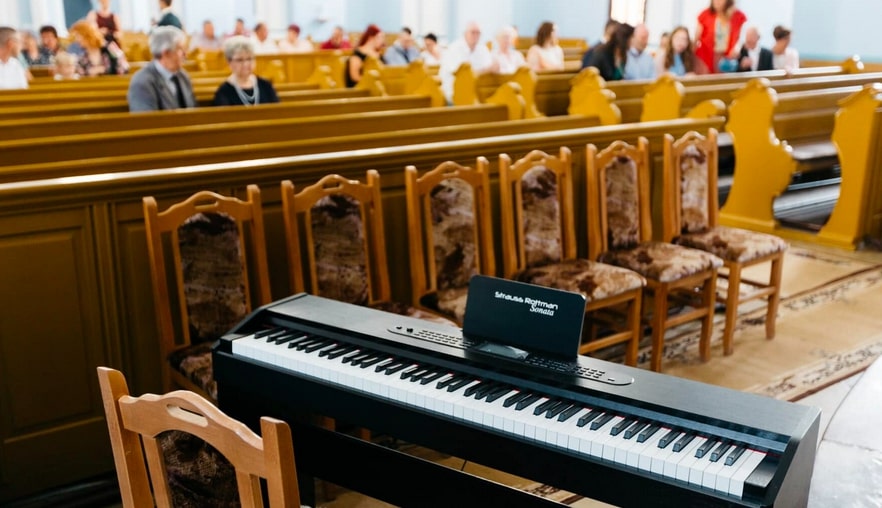
For the church setting, it is better to go with compact and portable options. But upright pianos could still be dependable and wonderful options for the church choir. Irrespective of the type of piano you opt for, make sure the instrument has the following features.
- Connectivity options: This is one of the best features to look for in a digital piano for use in religious establishments. Choose pianos with onboard speakers that can connect with amplifiers easily to start playing in any setting. It also ensures that everybody will be able to listen to music. Also, make sure the piano has USB connectivity with MIDI capabilities so that they connect with software systems and smart devices.
- Sound quality: Make sure that you choose a digital piano with realistic sounds for the church. There are ample models with high-quality speakers and large memory banks that also reproduce the sounds of other instruments. The more sounds on the keyboard, the better will it be able to produce sounds and imitate different music genres and styles.
- Piano touch and action: This is also an integral feature to look for in the piano as you are expected to play for long hours in the instrument. Make sure the instrument you buy is capable of producing natural and accurate sounds. Choose pianos with graded hammer action keys for realistic sounds.
Also Read: Best Digital Pianos for Intermediate Players
How to set up a digital piano for worship?
- Although most modern keyboards include a USB output for MIDI functionality, if you plan to play piano or organ sounds frequently, you might wish to choose a keyboard with excellent built-in sounds. You might not be overly concerned with MIDI and using software, especially if the style you are performing is more conventional.
- However, you can think about saving some money and purchasing a midi controller that enables you to control your music from a computer if the sort of music you are performing is more focused on synths, pads, and innovative sounds.
- You should absolutely take the keyboard’s weight into mind while choosing the finest one for worship. You should obviously consider the keyboard’s actual weight if you want to set up and break down your keyboard or transport it back and forth in your car. Up to 40–50 lbs. can be found on a full-size keyboard with 88 fully-weighted keys.
- We often avoid going lower than semi-weighted keys. All of the options below are at least semi-weighted, as you can see. Although this is a matter of taste, keep in mind your familiarity with the instrument, the genre of music, and the sounds you’ll be employing.
- You might prefer the semi-weighted keys if you play auxiliary keys primarily, such as synthesizers. But you’ll undoubtedly prefer the sensation of fully-weighted keys if you play the piano or organ primarily. especially if you didn’t learn piano on a keyboard, but rather on a real piano.
- This again depends on your preferences and the type of music you’re listening to. If you want to play mostly piano and organ parts, a full set of 88 keys would be preferred.
- However, you can certainly perform those aux key bits without using the entire set of keys. Should you need to switch octaves, a transpose button is always available.
To find out how to set up your digital piano according to your worship, you may refer to respective YouTube videos that show the model of the digital piano you own!
How can a piano player play church chords/music on the piano?
- Knowing how to recognize the sounds on the digital piano is among the most crucial skills to acquire before beginning to play the instrument. The majority of pianos have 88 keys.
- Even though there are only 12 different keys, there appear to be 88, which may seem like a lot to know. Simple, right? White piano keys stand for the notes A, B, C, D, E, F, and G. They should be simple to remember because they are related to alphabetic letters. On a piano, black keys are referred to as the sharps (#) or flats (b) of their adjacent white keys. As a result, they have two names, the first of which is G# or Ab, followed by A# or Bb, C# or Db, D# or Eb, and F# or Gb. Flats happen as you move down the keyboard, whereas sharps happen as you move up.
- Knowing what a major key is is crucial now that you are familiar with the locations of the various notes on a piano. Simply put, it is a group of notes that harmonize or sound good together. We have a total of 12 different major keys, so there are as many major keys as there are musical notes.
- Major scales are comparable to major keys. They are identical in terms of the notes they have. However, each phrase refers to a distinct component of musical theory.
- Seven notes make up every major key and major scale. The name of the key or scale is determined by the tonic note, which is the first note in the key.
- For instance, the G major key is a key or scale that begins with tonic note G. The G major key has the following notes: G, A, B, C, D, E, and F.
- In general, the word “major key” refers to the overall set of notes that a song or musical composition will be based on. As an illustration, if a song is in the key of G major, the chords and melody would be composed using the notes G, A, B, C, D, E, and F.
- There are seven notes in every major scale. An interval is a space between each note in a scale. Half step (H), which is just the note that is nearest to the one we are playing, is the smallest interval we are able to play (either black or white). The second crucial interval for creating a scale is a whole step (W), which is made up of two half steps. Now that you are aware of the two fundamental intervals. Major scales can be made using the following formula: W, W, H, W, W, W, H.
- You need to comprehend chords now that you are familiar with the names of the notes on the piano and how to perform scales.
- When three or more notes are played simultaneously, a chord is formed. The good news is that many modern worship songs can be played without having to know a lot of chords. Actually, all you need to know to begin playing are four basic chords.
What are the easiest songs a piano player can play in church?
- Amazing Grace: Why not open with one of the greatest tunes ever composed? Even if you don’t attend church, you’ve most likely heard this timeless hymn a few times on television or in motion pictures. It’s not only a lovely and well-known tune, but it’s also quite easy to play on the piano. This is undoubtedly one of the best simple tunes to play on the piano during church, despite being rather overused.
- How Great is our God?: Chris Tomlin is a gift for anyone who wants to learn simple Christian tunes. The worship leader’s music is really easy to learn whether you play the guitar, piano, or something else. One of Tomlin’s biggest hits, “How Great is Our God,” can be played by mastering just four basic chords. Everyone enjoys “How Great is Our God,” whether it is being played in a church context or at a youth event.
- Better is one day: The song “Better is One Day” gained popularity in the early years of the modern worship movement, despite being covered numerous times in recent years. The song, which Matt Redman sang, debuted in the late 1990s and quickly rose to prominence being one of the original anthems of the Passion movement. You only need to be familiar with a few techniques to play in the key of E like an expert.
- Redeemed: You’ve probably already watched piano lessons on classic hymns and early 2000s songs, so let’s look at something a little more modern. One of the excellent praise songs by Big Daddy Weave is “Redeemed” from the album “Love Come to Life,” which features a good piano beginning that isn’t too challenging to learn. Once the song starts underway, the words can have a significant impact on the worship experience at your church.
What type of digital pianos do churches use?
You must first realize that a church is not like other performing venues and that you must always consider the audience members while choosing a digital piano for a church. Diverse churches play different music, and various musical genres call for various instruments, tones, or even keyboard styles. For instance, some churches may only perform timeless tunes or hymns, wishing to hear the traditional sound of a grand or upright piano and perhaps some strings.
Other churches, on the other hand, have a rich legacy of gospel tunes that extensively incorporate jazzy or rhythm and blues chords, necessitating the usage of a machine with electric piano sounds.
The scope of how the church’s equipment is used should also be considered. Some smaller churches just require one individual to bring their own keyboard to services each week. Other churches are enormous, necessitating the purchase and permanent placement of a particular piano set.
Also Read: Korg B2 Review: Does it Plays Like a Real Piano?
Final Words
Now that we have seen the 5 best digital pianos for church use, let us move to the conclusion. If you have to port your piano to the church every time for practice, it is okay to go with a portable keyboard like the Roland GO or the Yamaha CP88. Else, you can opt for an upright piano such as Yamaha YDP 144 and 164 Arius, or Casio Privia PX 870, which offers the touch and feel of the grand acoustic pianos. We hope our choice of church pianos will help you in finding the best instrument for your music journey.
Recommendation
The Yamaha CP 88 is unquestionably one of the best keyboards you can get for internal sounds when it comes to playing gospel music. Professional musicians that need highly powerful electric pianos, acoustic pianos, and organs will appreciate the Yamaha CP 88. The CP 88 is thought to rival and even outperform the Nord keyboards in terms of quality. On the CP 88, there are 3 distinct pianos, each with unique characteristics. What a pleasant surprise these noises are.
The CP 88 doesn’t have as many sounds as other solutions that are frequently suggested for churches, but practically all of these sounds are excellent. One of the highly appreciated features of the CP 88 is its key bed. The natural wood gives the keys a tremendous weight and helps them closely resemble those of an acoustic piano. The weighted graded hammer action keys, which are renowned for simulating a real piano, are also present on the keys.
- 88 Natural Wood keys with Synthetic Ebony and Ivory Key Tops and Graded Hammer (GH3) Action
- Three premium grand pianos, two upright pianos and five electric pianos
- Master delay, reverb and EQ effects with dedicated realtime controls
Also check: Best Beginner Digital Pianos & Keyboards 2024
Frequently Asked Questions (FAQs)
1. What Are Two Approaches to Learning Worship Pianos?
The most typical one is mastering sheet music reading, which necessitates knowledge of both bass and treble clef notation. While reading notes is definitely useful, the process can be sluggish and drawn out. You may also play songs combining lyric sheets with chords by learning how to play various chords on the keyboard.
2. What is the Best Option for a Keyboard to Buy That Falls Under the Nominal Budget?
The most recent stage piano from Roland, the RD 88, is designed for musicians on a tight budget. Having said that, it’s not the most affordable keyboard you can purchase, but it’s also high-quality. More than 3,000 different sounds are included in the RD 88, along with controls that let you rapidly alter sounds.
3. Give a Tip While Playing Basic Chords or Chord Progressions.
Make sure to put your fingers correctly when playing chords. Play the note G with your thumb, the note B with the middle finger, and the note D with your pinky when playing the G major chord, for instance. By doing this, you will reduce the amount of stress in your hand and begin creating the proper habits.
4. What is the Most Prominent Worship Song Played Across All Churches?
“How He Loves” only needs a few fundamental chords to be played, just like some of the other simple songs to play on the piano at church. It also has a moderately modest tempo, making it perfect for young or inexperienced players.
5. How Do Faders, Knobs, and Buttons Play a Role?
You have more in-set control over many things like a cut-off, reverb, delay, which patch you’re playing, track triggering, tap tempo, lighting control, etc. the more faders, knobs, and buttons you have. An external controller with buttons and knobs is another option.


